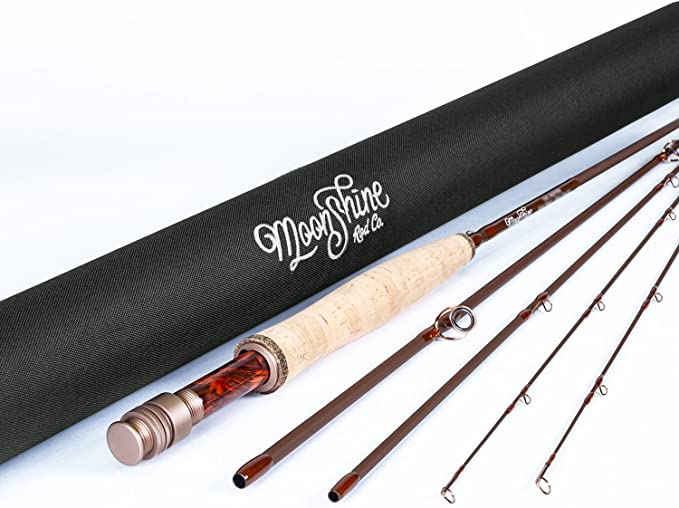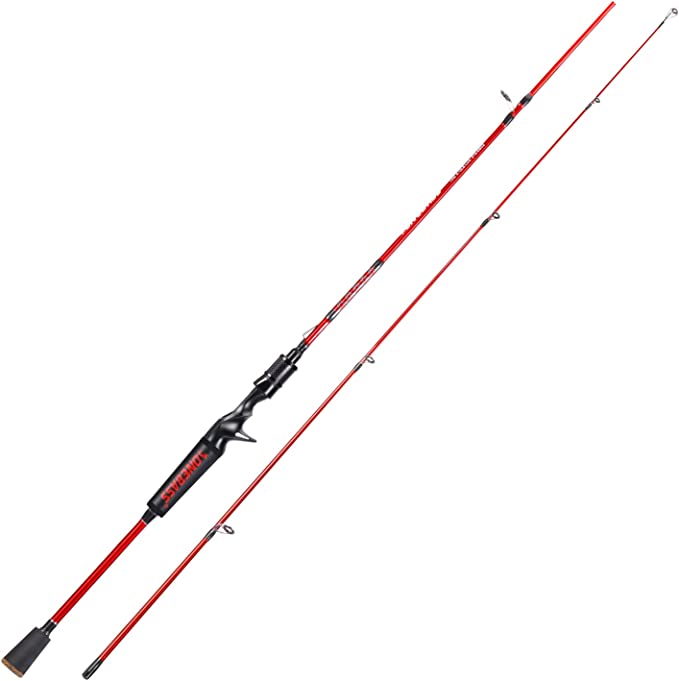The Soul of the Cast: Deconstructing the Science and Philosophy of a Modern Fly Rod
Update on Aug. 1, 2025, 12:50 p.m.
There is a moment in fly fishing that borders on the sublime. It’s when conscious thought evaporates, and the boundary between intent and action dissolves. Your mind pictures a ghostly loop of line unfurling against the sky, and a split second later, it happens. The fly, a tiny bundle of feather and thread, lands exactly where you imagined, as gently as a falling leaf. In that moment, the fly rod in your hand ceases to be a mere object. It becomes a translator—an instrument that converts the subtle language of your will into the elegant physics of the cast.
But what, exactly, makes a good translator? What is the secret language spoken between the angler and the river, and how does a nine-foot length of carbon fiber learn to speak it so fluently? We can begin to find an answer by looking closely at a rod like the Moonshine Rod Co. Drifter II. Not as a product to be reviewed, but as a case study—a tangible example of the science, engineering, and design philosophy that define a modern, high-performing fly rod that doesn’t demand a second mortgage.
The Invisible Spine: The Language of Energy
At the core of any modern fly rod lies its blank, and the Drifter II’s is crafted from high-modulus carbon fiber. This term, “high modulus,” is central to understanding the rod’s performance. In material science, modulus refers to a material’s stiffness-to-weight ratio. A high-modulus material, like the advanced graphite used here, is incredibly stiff for its low weight. Think of a track sprinter’s leg: it must be light enough for explosive speed but powerful and rigid enough to transfer immense force to the ground without buckling.
This is precisely what a high-modulus blank does. Its lightness contributes to an “excellent swing weight,” drastically reducing angler fatigue over thousands of casts. But its stiffness is the true game-changer. It creates a highly efficient conduit for energy. When you make a cast, you are loading the rod with potential energy, bending it like a spring. A high-modulus blank stores that energy with minimal loss and releases it with explosive speed upon the forward stroke. This rapid “recovery rate”—the speed at which the blank straightens and stops oscillating—is what creates tight, stable loops and allows the line to “shoot long distances.”
This material works in concert with the rod’s “moderate-fast action.” The action, determined by the blank’s taper, dictates how the rod bends and releases its stored energy. A moderate-fast action finds a beautiful equilibrium. It has enough power in its lower sections for authority and distance, but enough flexibility toward the tip to provide feedback and forgive minor imperfections in an angler’s timing. It’s a versatile dialect, fluent in both the powerful pronouncements of “long double hauls” and the quiet whispers of a delicate roll cast, making it an intuitive translator for anglers of all skill levels.
The Critical Touchpoints: A Dialogue with the World
If the blank is the rod’s spine, the components are its nervous system—the critical points of contact through which it communicates with the world. Here, small details make a profound difference.
Consider the “SiC stripping guides.” Silicon Carbide (SiC) is a remarkable ceramic, ranking just below diamond in hardness and possessing an exceptionally low coefficient offriction. When your fly line, under tension, screams through these guides during a long cast or a powerful run from a fish, two things happen. The ultra-smooth surface minimizes friction, which not only allows for longer, smoother casts but also reduces the generation of heat that can degrade and weaken an expensive fly line over time. The guides become silent partners in efficiency.
Then there is the handle, your primary interface with this entire system. The “AAA grade cork” is more than a comfortable place to hold. The natural cellular structure of cork, composed of millions of tiny air-filled cells, is a phenomenal vibration dampener. It acts as a filter. It deadens the harsh, unhelpful vibrations from a clumsy cast but telegraphs the essential, electric signals—the subtle tick of a nymph bumping along the riverbed, the almost imperceptible sip of a trout—directly to your palm. It lets you feel the life at the other end of the line.
Designed for Failure: The Pact of Trust
Perhaps the most telling aspect of the Drifter II’s design philosophy is not its performance, but its pragmatism. It comes with an “extra tip section.” This is more than a generous perk; it is an acknowledgment of reality and a core principle of sound engineering: redundancy. In any complex system, you identify the most likely point of failure and build in a backup. A fly rod’s tip is, by far, its most fragile part. An errant tree branch or a hastily closed car door can end a day, or even an entire trip. By including a spare, the design anticipates failure and provides an immediate solution. It’s the spare tire in the trunk—you hope you never need it, but its presence provides immense peace of mind.
This philosophy extends to the “lifetime manufacturer’s warranty.” This is a pact of trust between the maker and the angler. However, it’s also important to view this pact within the context of the modern marketplace. As some users have discovered, “lifetime” can be contingent on the availability of parts for a model that may eventually be discontinued. This isn’t a uniquely Moonshine issue; it’s a complex reality for many brands in an industry driven by innovation. It highlights a deeper conversation about sustainability and the longevity of our gear. A warranty is a promise, and the truest test of that promise is not just replacing what breaks, but fostering a relationship that navigates these challenges with transparency.
An Accessible Symphony
In the end, the Moonshine Drifter II is compelling not because of any single feature, but because of the symphony created by all its parts working in concert. The efficient energy transfer of its carbon blank, the frictionless flow through its SiC guides, the clear feedback from its cork grip, and the pragmatic safety net of its extra tip all serve a single, unifying philosophy: to make the rich, nuanced experience of high-performance fly fishing more accessible and more reliable.
It proves that a deep understanding of science and a user-centric approach to engineering can democratize quality. It strips away the mystique and invites us to look closer. So the next time you hold a fly rod, any fly rod, pause for a moment. Feel its balance. Flex its spine. See it not just as a tool, but as a carefully crafted instrument. And as you cast, listen closely. You might just hear it telling you a story of materials, physics, and the timeless dream of placing a fly, perfectly, upon the water.





















